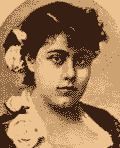Mother Dilbar Jahan Khanum Place of burial Cairo, Egypt House Muhammad Ali dynasty | Name Ayn-al-Hayat Rifaat Religion Sunni Islam | |
 | ||
Born 5 October 1858
Cairo, Egypt ( 1858-10-05 ) Spouse Hussein Kamel (m. 1873 - div.) Issue Prince Husain Kamal ud-din Pasha
Prince Saif ud-din Bey
Ahmad Nazim Bey
Prince Yusuf Kamil Bey
Princess Kazima Khanum Effendi Father Prince Ahmad Rifa'at Pasha Died August 12, 1910, Paris, France Children Prince Kamal el Dine Hussein Parents Prince Ahmad Rifa'at Pasha, Dilbar Jahan Khanum Similar People Hussein Kamel of Egypt, Prince Kamal el Dine Hus, Muhammad Ali of Egypt | ||
Ayn-al-Hayat Rifaat (Turkish: Aynelhayat Rifaat) (5 October 1858 - 12 August 1910) (Ayn-al-Hayat meaning "Spring of life") was an Egyptian princess and a member of the Muhammad Ali Dynasty. She was the first wife of Hussein Kamel of Egypt.
Contents
Early life
Princess Ayn-al-Hayat was born on 5 October 1858, and was the eldest daughter of Prince Ahmad Rifa'at Pasha, sometime President of Council of State and his second wife Dilbar Jahan Khanum. She had a brother, Prince Ahmad Pasha, who was a man greatly esteemed foe his love of justice and the austerity of his life. Ayn-al-Hayat, was still a child when her father met his tragic end. Dark, petite, and vivacious, she had great charm. Her uncle, the Khedive Ismail, was very fond of her and took a personal interest in her education.
Marriage
In order to introduce her to study he used to say: "If you really try to learn your lessons and all your teachers are satisfied, I shall marry you to my son Hussein." The child was so delighted with the idea that once when she was twelve she ran out to meet her uncle, who had come to see her, saying: "Today all my teachers are pleased. Now may I marry Hussein Agha bey?" The marriage took place in due course on 30 January 1873 and zifaf on 7 February 1873. Prince Hussein was devoted to his wife, who at first appeared to be happy. Then quite suddenly she insisted on a divorce and obtained her freedom. Princess Ayn-al-Hayat never remarried.
Children
They had five children:
Organization
She is remembered as a founder and first president of the Muhammad Ali Benevolent Society in 1909. The members of its community were all women, something till then unheard of in the annals of the Middle East. Medical and financial advisers were the only men consulted. The society began by opening a dispensary for women and children in the populous quarter behind the Abdeen Palace. The funds were chiefly supplied from the Princess's own resources and by donations from the Khedival family, as it then existed. According to the rules of the society, the president was always to be a princess of the ruling family.
Death and aftermath
Princess Ayn-al-Hayat died on 12 August 1910 at Paris, France and was buried in the mausoleum of Hosh al-Basha, Imam al-Shafi'i, Cairo. After her death, Princess Nazli Halim became the president of Muhammad Ali Benevolent Society. She was followed by Princess Fawzia, who was the president of the organization to come from the royal house.
